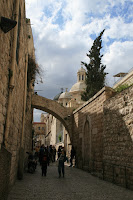The "Jerusalem" in the title of Jerusalem Trilogy (Knight of Jerusalem, Defender of Jerusalem, and Envoy of Jerusalem) refers to the kingdom and king of the same name more than the city itself, yet it would have been impossible to write this trilogy of novels without having visited Jerusalem. Jerusalem was not only the capital of the kingdom by that name, it was the call, the magnet, the symbol and the heart of crusades and the crusader kingdoms.
While men fought and died for the abstract notion of "Jerusalem," and the city was also the ultimate pilgrimage destination of medieval Christians because it was the site of Christ's Crucifixion and Resurrection. Yet, despite all that, it remained a very real, secular and material city as well. Furthermore, it had a long history of habitation. For the inhabitants of Jerusalem in the period of my books (1170-1192), the city already had a rich history and its face and character were the product of diverse influences.
Jerusalem was, of course, originally a Jewish city. In the crusader period, the most important monument dating to the Jewish kings was the Tower of David, which formed an integral part of the medieval Citadel.
Jerusalem was, of course, originally a Jewish city. In the crusader period, the most important monument dating to the Jewish kings was the Tower of David, which formed an integral part of the medieval Citadel.
 |
| The Tower of David as it looks today. |
Jerusalem had also been a Roman city, most importantly, at the time of Christ. The venue of key episodes in Christ's life were Roman, e.g. the palace of Pontius Pilate. But although some Roman columns and mosaics survived and were integrated into later architecture, very little is recognizable today. The Mount of Olives, however, cannot have changed all that much. Here a picture as it looks today:
The Byzantine city has also largely been effaced what came afterwards, but here is a model that historians have developed based on archaeological research:
The Byzantine city has also largely been effaced what came afterwards, but here is a model that historians have developed based on archaeological research:
The Arabs were the most recent inhabitants of Jerusalem before the crusader period, and the most spectacular of their monuments was the "Dome of the Rock" erected on the Temple Mount. The Crusaders admired this structure greatly and far from defacing, damaging, destroying or neglecting it, they turned it into a church, the "Temple of God," and raised a cross over the dome in place of the half moon of Islam. Here are a couple of modern photos of the Temple Mount today, with the Dome of the Rock restored to a mosque.
The crusaders, however, also left a remarkable imprint upon Jerusalem. The most famous of the crusader/Frankish monuments is, of course, the Church of the Holy Sepulcher:
But the Church of St. Anne is also a masterpiece of Frankish architecture which has survived so well because it was converted into a mosque in the period after Jerusalem was re-captured by Saladin. It is now a church again:
But what was Jerusalem like when Balian actually lived there? Find at more at: The Heart of the Crusader Kingdom.
Jerusalem is particularly important as a venue in the first two books of the trilogy:
Buy now! Buy now! Buy now!

















No comments:
Post a Comment